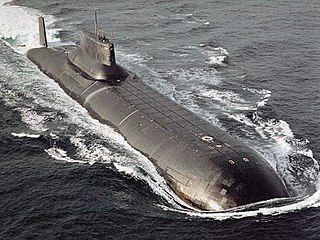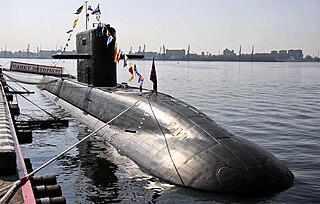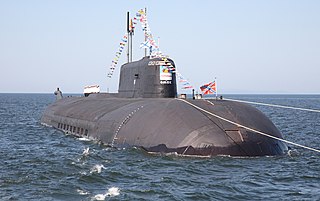
The Typhoon class, Soviet designation Project 941 Akula, was a class of nuclear-powered ballistic missile submarines designed and built by the Soviet Union for the Soviet Navy. With a submerged displacement of 48,000 tonnes, the Typhoons were the largest submarines ever built, able to accommodate comfortable living facilities for the crew of 160 when submerged for several months. The source of the NATO reporting name remains unclear, although it is often claimed to be related to the use of the word "typhoon" ("тайфун") by General Secretary Leonid Brezhnev of the Communist Party in a 1974 speech while describing a new type of nuclear ballistic missile submarine, as a reaction to the United States Navy's new Ohio-class submarine.

Lada class, Russian designation Project 677 Lada is the new advanced class of diesel-electric attack submarine designed by the Russian Rubin Design Bureau. A program to develop a "fourth generation" diesel-electric submarine, it aimed to produce a highly improved version of the Project 636 with better acoustic signature, new combat systems and possibly air-independent propulsion. However, in 2019, Alexander Buzakov, the head of the Admiralty Shipyard, indicated that there were no plans to equip the Lada class with an air-independent propulsion system. In July 2022 it was reported that work on an electrochemical generator to produce hydrogen from diesel fuel and oxygen was continuing and that the Rubin Central Design Bureau signed a new contract in 2019 to continue work. This was scheduled to be completed by the mid-2020s. In 2023, the decision was taken to decommission and scrap the lead ship of the class, the Sankt Peterburg due to the very high costs of modernising the submarine.

The Borei class, alternate transliteration Borey, Russian designation Project 955 Borei and Project 955A Borei-A, are a series of nuclear-powered ballistic missile submarines being constructed by Sevmash for the Russian Navy. The class has been replacing the steadily retiring Russian Navy Delta III and Delta IV classes and fully retired Typhoon, all three classes being Soviet-era submarines.

Dmitriy Donskoy is a decommissioned Russian Navy nuclear ballistic missile submarine, designated Project 941 Akula class.

The Yasen class, Russian designations Project 885 Yasen and Project 885M Yasen-M, also referred to as the Graney class, are a series of nuclear-powered cruise missile submarines designed by the Malakhit Marine Engineering Bureau and built by Sevmash for the Russian Navy. Design work commenced in earnest in the 1980s with the first submarine built in the 1990s–early 2010s with commissioning in 2013. Two additional boats to an upgraded Yasen-M design were commissioned in 2021 and six more are under construction. Based on the Akula class and Alfa class designs, the Yasen class is projected to replace the Russian Navy's current Soviet-era nuclear attack submarines. The Akula class is optimised for a hunter-killer role, whereas the Yasen class concept uses the platform as a nuclear guided missile submarine (SSGN).

Admiral Nakhimov is the third battlecruiser of the Russian Navy's Kirov class. The ship was originally commissioned into service with the Soviet Navy in 1988, known back then as Kalinin (Калинин), a name the ship kept until 1992 when it was renamed for Pavel Nakhimov. From 1997 Admiral Nakhimov is undergoing a repair and a refit to receive new and improved weaponry and had been scheduled to re-enter service with the Russian Navy in around 2022. The date for the ship's return to service is uncertain. In 2021 it was reported that the ship's return to service would be delayed until "at least" 2023 while in February 2022 it was reported that Sevmash CEO Mikhail Budnichenko noted that the warship was planned for delivery in 2022. Later in the year it was again reported that the vessel's return to service might be delayed as late as 2024, with this being eventually confirmed by the head of United Shipbuilding Corporation Alexei Rakhmanov.

JSC PO Sevmash is a Russian joint-stock company (JSC) under the vertically-integrated United Shipbuilding Corporation. The shipbuilding operations of Sevmash is in the port city of Severodvinsk on the White Sea in the Russian Federation.

K-560 Severodvinsk is a Yasen class nuclear-powered cruise missile submarine of the Russian Navy, and the lead vessel of the class. The submarine is named after the city of Severodvinsk. She is deployed with the Russian Northern Fleet.

K-561 Kazan is a Yasen-class nuclear-powered cruise missile submarine of the Russian Navy. It is the second boat of the project, separated from the first by 16 years (1993–2009). Considerable changes were made to the initial design. Differences in the project have appeared sufficient to consider it as a new upgraded version Yasen-M. The submarine is named after the city of Kazan. The submarine is deployed with the Russian Northern Fleet.

K-549 Knyaz Vladimir is a Borei-class nuclear-powered ballistic missile submarine, and the first upgraded Borei-A unit to enter service with the Russian Navy. The submarine is named after Knyaz Vladimir the Great.

Knyaz Oleg is a Borei-class nuclear-powered ballistic missile submarine developed by the Rubin Design Bureau and constructed by the Sevmash for the Russian Navy. The submarine is named after Oleg of Novgorod.
The K-119 Voronezh is an Oscar-class submarine in the Russian Navy.

The K-150 Tomsk is an Oscar-class submarine in the Russian Navy.

The K-186 Omsk is an Oscar-class submarine in the Russian Navy.

The K-410 Smolensk is an Oscar-class submarine in the Russian Navy.
The K-132 Irkutsk is an Oscar-class submarine in the Russian Navy.

The K-328 Leopard is an Akula-class submarine in the Russian Navy.
K-571 Krasnoyarsk is a Yasen-class nuclear-powered cruise missile submarine of the Russian Navy. It is the third boat of the project Yasen-M. Considerable changes were made to the initial Yasen design. Differences in the project have appeared sufficient to consider it as a new upgraded version Yasen-M. The submarine is named after the city of Krasnoyarsk.
Generalissimus Suvorov is a Borei-class nuclear-powered ballistic missile submarine developed by the Rubin Design Bureau and constructed by the Sevmash for the Russian Navy. The submarine is named after Alexander Suvorov.














